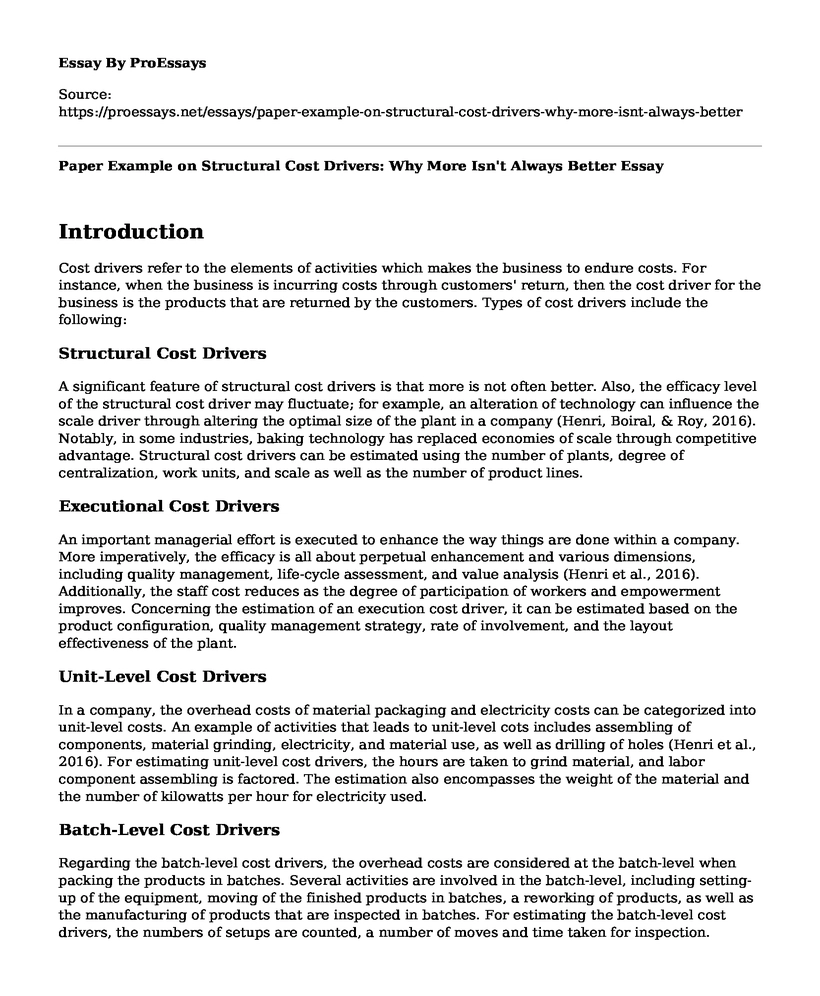Introduction
Cost drivers refer to the elements of activities which makes the business to endure costs. For instance, when the business is incurring costs through customers' return, then the cost driver for the business is the products that are returned by the customers. Types of cost drivers include the following:
Structural Cost Drivers
A significant feature of structural cost drivers is that more is not often better. Also, the efficacy level of the structural cost driver may fluctuate; for example, an alteration of technology can influence the scale driver through altering the optimal size of the plant in a company (Henri, Boiral, & Roy, 2016). Notably, in some industries, baking technology has replaced economies of scale through competitive advantage. Structural cost drivers can be estimated using the number of plants, degree of centralization, work units, and scale as well as the number of product lines.
Executional Cost Drivers
An important managerial effort is executed to enhance the way things are done within a company. More imperatively, the efficacy is all about perpetual enhancement and various dimensions, including quality management, life-cycle assessment, and value analysis (Henri et al., 2016). Additionally, the staff cost reduces as the degree of participation of workers and empowerment improves. Concerning the estimation of an execution cost driver, it can be estimated based on the product configuration, quality management strategy, rate of involvement, and the layout effectiveness of the plant.
Unit-Level Cost Drivers
In a company, the overhead costs of material packaging and electricity costs can be categorized into unit-level costs. An example of activities that leads to unit-level cots includes assembling of components, material grinding, electricity, and material use, as well as drilling of holes (Henri et al., 2016). For estimating unit-level cost drivers, the hours are taken to grind material, and labor component assembling is factored. The estimation also encompasses the weight of the material and the number of kilowatts per hour for electricity used.
Batch-Level Cost Drivers
Regarding the batch-level cost drivers, the overhead costs are considered at the batch-level when packing the products in batches. Several activities are involved in the batch-level, including setting-up of the equipment, moving of the finished products in batches, a reworking of products, as well as the manufacturing of products that are inspected in batches. For estimating the batch-level cost drivers, the numbers of setups are counted, a number of moves and time taken for inspection.
Product-Level Cost Drivers
The cost of product line scheduling is categorized under product-level cost. For instance, several activities will lead to product-level costs, including testing of products and designing of the product (Henri et al., 2016. Estimating the cost include the number of products, procedures, and change orders.
High-Low Method
The high-low method refers to the separation of the fixed and variable cost in limited organizational data. It requires the comparison of the total cost at every level after involving both low and high-level activities of the organization (Zhang, & Lu, 2014). An organization would use the high-low method in computing the total costs of various units for a specific production.
Regression Analysis Method
The regression analysis method utilizes the dependent variable and the explanatory variables in establishing an equation to allow estimation of values for the dependent variables. The models used in the regression analysis include the output model that gives information on the estimation of the dependent variable (Oczkowski, & Doucouliagos, 2015). An organization can use regression analysis when studying greenhouse gas emissions, which uses a model with variables such as gross domestic product, Fossil fuels, population, and vehicle usage.
References
Henri, J. F., Boiral, O., & Roy, M. J. (2016). Strategic cost management and performance: The case of environmental costs. The British Accounting Review, 48(2), 269-282. Retrieved from: https://www.sciencedirect.com/science/article/pii/S0890838915000128
Oczkowski, E., & Doucouliagos, H. (2015). Wine prices and quality ratings: A meta-regression analysis. American Journal of Agricultural Economics, 97(1), 103-121. Retrieved from: https://academic.oup.com/ajae/article-abstract/97/1/103/2737501
Zhang, X., & Lu, Y. (2014). Centrifugal spinning: an alternative approach to fabricate nanofibers at high speed and low cost. Polymer Reviews, 54(4), 677-701. Retrieved from: https://www.tandfonline.com/doi/abs/10.1080/15583724.2014.935858
Cite this page
Paper Example on Structural Cost Drivers: Why More Isn't Always Better. (2023, Apr 09). Retrieved from https://proessays.net/essays/paper-example-on-structural-cost-drivers-why-more-isnt-always-better
If you are the original author of this essay and no longer wish to have it published on the ProEssays website, please click below to request its removal:
- The Legal Framework of International Investment Protection
- Business Research Paper Sample: Small Entrepreneurship
- Voluntary Income Tax Assistance Essay
- Paper Example on Fraud Management
- Essay Sample on State's Capital Budgets
- Ethical Concerns Affect the Role of Business in Society Essay Example
- Filing a Dispute to Amendment Assessment and Limits







